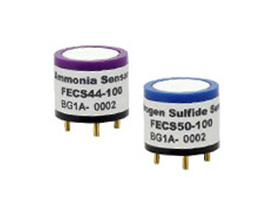Ⅰ. Safety Precautions for Use of Figaro Gas Sensors
- Carefully read product information and other technical information provided by Figaro before using our products, and confirm specifications and operating conditions.
- When designing an application circuit, please make sure that an accidental short circuit or open circuit of other electronic components would not cause the sensor to be subjected to excessive voltage, current, or temperatures exceeding the rated values.
- When designing application products, please make sure that a gas sensor malfunction would not
1) cause adverse effects on other components,
2) directly or indirectly impair the safety of application products that use gas sensors (e.g., emit smoke, cause fire, or other unstable states of application products). - Consider adding safety measures for fail-safe where necessary, such as a protection circuit.
[an error occurred while processing this directive]


Ⅱ. Cautions for Use of Electrochemical-type (FECS Series) Gas Sensors
【Conditions for use and storage】
-
1) Rated temperature and humidity conditionsUsing or storing the sensor in an environment outside the rated temperature and humidity range may cause physical damage and/or affect the sensor characteristics.
-
2) Storage conditions* Store the sensor in clean ambient air of normal temperature and humidity; recommended temperature from 0˚C
* When the sensor is removed from a PC board and is stored, the reference electrode pin and the working electrode pin should be short-circuited using a shorting clip. -
3) CondensationIf water condenses inside the sensor housing, sensor characteristics may drift.
-
4) Oxygen concentrationThe sensor cannot operate continuously in a zero oxygen content atmosphere.
-
5) High concentration of gasesSensor performance may be affected if exposed to a high concentration of gases for a long period of time during the operating or storage period.
-
6) Organic vaporsIf the sensor is exposed to organic vapors generated from alcohol, acetone, volatile oil etc., organic vapors will adsorb onto the sensing element surface, and sensor performance may be affected.
-
7) Dusts and oil mistSensor performance may be affected if exposed where dust, fine particles, or oil mist is present.
-
8) Detection of ammoniaIf an ammonia sensor is exposed to an environment containing ammonia for a long time, sensitivity of the sensor may be temporarily reduced. The sensor should gradually recover to its initial sensitivity after it is removed to clean air. A test should be conducted under the customers' own conditions to ensure that the sensors are suitable for their own requirements.
【 Handling 】
-
1) Applied voltageDo not apply voltage to the sensor. If voltage is applied to the sensor pins, sensor characteristics may be affected. Do not use the sensor once the voltage required for electrolysis of water or higher is applied.
-
2) Shorting clipSensors are shipped short-circuited. Remove a shorting clip connected between the reference pin and the working pin just before use.
-
3) Mechanical shock and vibrationAvoid mechanical shock. Change in sensor characteristics or electrolyte leakage may occur if the sensor is subjected to a strong shock or vibration. Do not use the sensor if subjected to a drop or other mechanical shock.
-
4) No soakingAvoid contact with water. Sensor characteristics may be affected due to soaking or splashing the sensor with water.
-
5) No disassembly or deformationUnder no circumstances should the sensor be disassembled, nor should the sensor structure be deformed. Electrolyte leakage may occur as a result. Such action would void the sensor warranty.
-
6) Gas inletDo not block the gas inlet of sensor. The sensor would not work properly with a clogged inlet.
-
7) Non-woven filterDo not remove the non-woven filter on the sensor top, and do make it dirty. Do not insert foreign objects through the non-woven filter. This may damage the sensor, leading to leakage of electrolyte.
【 Mounting process 】
-
1) SolderingAlways use appropriate pin sockets to install the sensor onto a PC board. Do not solder sensor pins. Soldering the sensor pin may lead to leakage of electrolyte.
-
2) Electrical connector greaseDo not use electrical connector grease when installing the sensor into circuit. This may lead to deterioration of the sensor housing material.
-
3) Resin coatingWhen a resin coating is applied on a printed circuit board for improving its resistance to moisture, the chemical solvent contained in the coating material may affect sensor characteristics. Sample testing should be conducted to see if this process would adversely affect sensor characteristics.
-
4) Electro static dischargeExercise necessary precaution against ESD during mounting of the sensors on finished instruments.
-
5) ResonanceExcessive vibration may cause damage of the sensor structure or breakage of the sensor components at the resonance frequency. Usage of compressed air drivers or ultrasonic welders on assembly lines may cause such vibration to the sensor. Before using such equipment, preliminary tests should be conducted to verify that there will be no influence on sensor characteristics.
【 Application design 】
-
1) Foreign conductive objectsIf foreign conductive objects get into the sensor, short-circuit may occur inside the sensor. When such conditions are expected to be encountered, installation of an external air filter is recommended.
-
2) Calibration and adjustmentPeriodic calibration and adjustment are required to maintain proper sensor performance. Perform calibration and adjustment at an appropriate interval according to the detection accuracy required; typically once a year or every six months.
-
3) Fitness for purposeBefore usage of the sensor, customers should verify and ensure that the sensor will work properly under the conditions where they intend to use it and that the sensor is fit for the purpose for which customers wish to use it.


